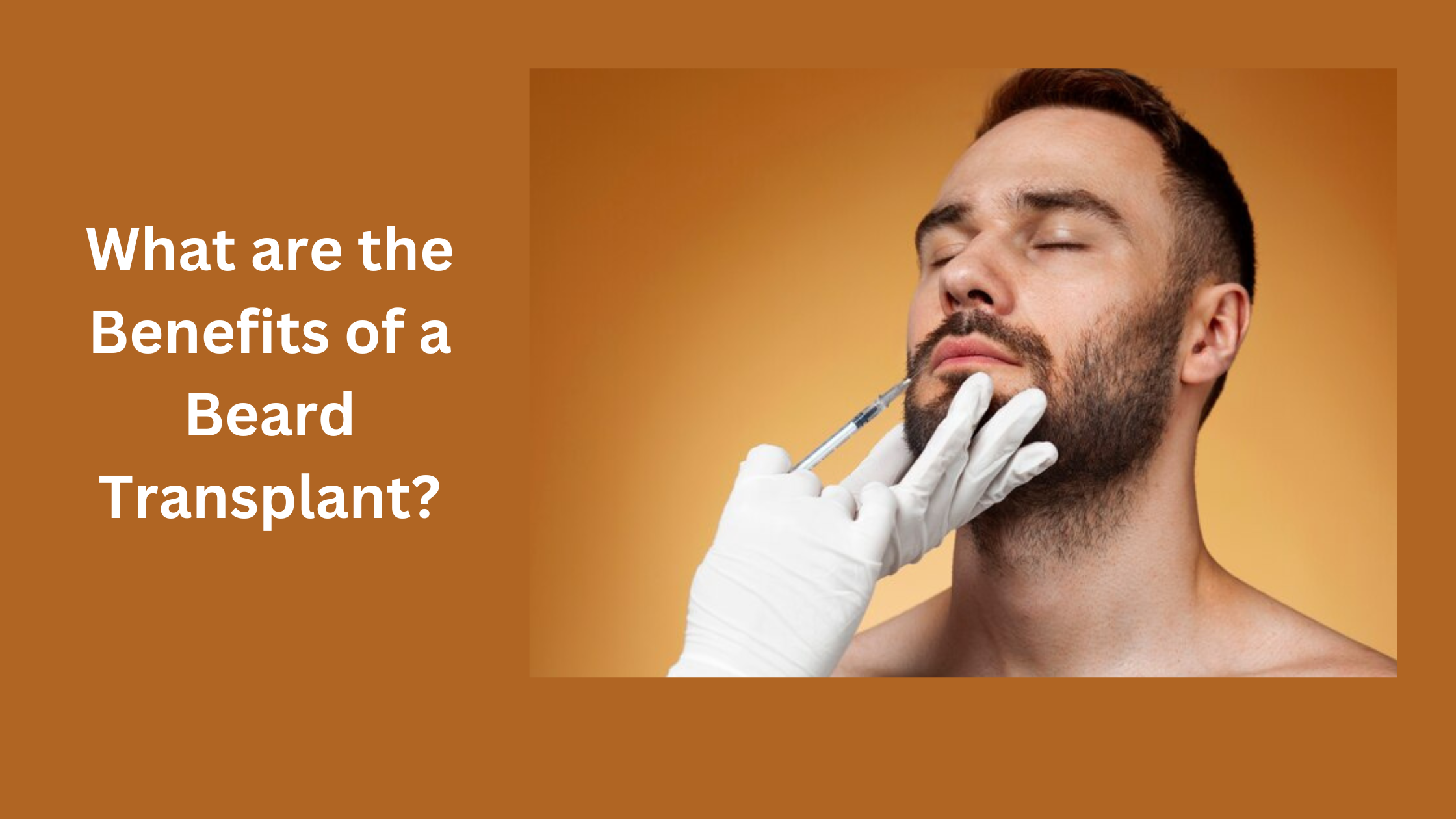A beard hair transplant is a revolutionary surgical procedure to enhance facial hair's density and appearance. This increasingly popular method involves relocating hair follicles from a donor area, typically the back or sides of the scalp, to the beard transplant region. Developed for men who struggle with patchy or sparse beard growth, have scarring that prevents hair development, or want to enhance the thickness and shape of their beard, this procedure offers a permanent solution. The results are impressive, with transplanted hair growing naturally and allowing for regular grooming and styling. Ultimately, a beard transplant improves facial hair aesthetics, boosts morale, and helps individuals achieve their desired beard style.
What is a Beard Hair Transplant?
A beard transplant is a surgical procedure that enhances the density and appearance of facial hair. This technique involves relocating hair follicles from a donor area, typically the back or sides of the scalp, to the designated beard region. The process is meticulously performed to ensure that the transplanted hair blends seamlessly with the existing facial hair, resulting in a natural-looking and fuller beard.This procedure is particularly beneficial for men who experience patchy or sparse beard growth; beard transplants have scars that inhibit hair growth or desire to improve the consistency and form of their beard. The results are permanent, with the transplanted hair growing like natural facial hair, allowing regular grooming and styling. A beard transplant offers an effective solution for men seeking to enhance their facial hair aesthetics, boost their confidence, and achieve their desired beard style.
How Does the Beard Transplant Procedure Work?
The beard transplant process starts with a consultation, during which patients can discuss their plans and set realistic expectations. A suitable donor area is selected, and a beard transplant is typically performed at the back of the scalp, which is chosen for its resilient hair quality. Two primary techniques for extracting hair follicles are used.
Consultation
The process begins with a free hair transplant consultation with Dr. John Kahen, during which the patient's goals and the procedure's feasibility are discussed. This initial talk is crucial for developing realistic expectations and determining the best approach to achieve the desired beard density and shape.
Donor Area Selection
A suitable donor area, usually at the back of the scalp, is chosen for its resistance to balding, ensuring the longevity of the transplanted hair. This step is essential for selecting the highest-quality hair follicles that will provide the most natural and long-lasting results for the beard transplant.
Follicle Extraction
Hair follicles are extracted from the donor area depending on the chosen method. Achieving this plan generally involves two primary methods:
- FUE Hair Transplant: Hair follicles are extracted from the donor area. Usually, the back of the scalp is used with a specialized tool. Renowned for its precision and minimal scarring, the FUE beard transplant technique is preferred among patients wary of visible scars, emphasizing its appeal in hair restoration.
- FUT Hair Transplant: Fut beard transplant, commonly called the strip method. The Follicular Unit Transplantation (FUT) procedure involves removing a small strip containing hair strands from the donor area. The strip is then dissected into individual follicles under a microscope. While this method may leave a linear scar, it allows harvesting many follicles in a single session.
Implantation
Once the hair follicles have been harvested, the next step is their careful implantation into the beard area. Dr. Kahen employs meticulous techniques to guarantee the accurate order of each follicle, replicating the natural growth pattern of facial hair with precision. This painstaking attention to detail leads to a natural-looking and aesthetically pleasing beard.
Recovery
Following a beard hair transplant, recovery is typically swift and relatively comfortable. During the initial recovery period, it's common to experience some redness and swelling in the regaled area. These side effects are usually mild and subside within a week. Dr. Kahen offers detailed aftercare instructions to promote a smooth and swift recovery, reducing the chances of complications and enhancing the transplant's success.
Benefits of a Beard Hair Transplant
Undergoing a beard hair transplant at Beverly Hills Hair Restoration can be transformative, offering numerous advantages beyond mere aesthetics. Expertly conducted by one of the top hair transplant surgeons in Los Angeles, this procedure enhances facial appearance and boosts self-confidence and overall satisfaction with one's looks.The benefits of beard transplants are enduring, providing permanent results that allow individuals to enjoy a fuller, more robust beard without needing ongoing treatments or maintenance. The transplanted hair blends seamlessly with existing facial hair, ensuring a realistic look. Additionally, the procedure is highly customizable, offering patients precise control over the density and shape of their beard to achieve their desired look. Most patients recover quickly, often returning to their normal activities shortly after the procedure. Furthermore, the transplanted beard requires no more maintenance than natural facial hair, causing it a low-effort enhancement to one's grooming routine.
Minimally Invasive Procedure
One of the primary advantages of beard transplants is their minimally invasive nature. At Beverly Hills Hair Restoration, only small incisions are required to harvest and implant hair follicles, unlike more extensive surgical procedures. This minimal approach offers significant patient benefits, such as reduced pain, faster healing, and minimal scarring. Local anesthesia is typically used, lowering the risks associated with general anesthesia. As a result, patients can enjoy a more comfortable understanding and a more rapid return to daily activities, all while achieving their desired beard aesthetic.
Faster Recovery Time
Beard transplants offer a notably faster recovery compared to traditional hair restoration methods. Most patients experience a swift healing process at our Los Angeles clinic, often resuming normal activities within just a few days. This quicker recovery minimizes disruption to daily life, allowing for a prompt return to work and social engagements. With reduced downtime, patients also spend less while away from physical activities and hobbies, making beard transplants an efficient and attractive option for those seeking effective hair restoration.
Minimal Pain or Discomfort
One of the most appreciated benefits of beard transplants is the minimal pain or discomfort involved. At Beverly Hills Hair Restoration, advanced techniques paired with local anesthesia make the procedure comfortable for patients. After the transplant, any mild discomfort can usually be managed with over-the-counter pain relief. This lowered pain level is essential for patient comfort, making it easy to undergo the procedure with confidence. Minimal discomfort further enhances the experience for those looking to improve their facial aesthetics.
Local Anesthetic Only
Beard transplants at Beverly Hills Hair Restoration are performed with just a local anesthetic, allowing patients to remain awake and comfortable without needing general anesthesia. This system reduces risks like nausea and extended recovery time associated with deeper sedation. Patients can leave the clinic after the procedure, enjoying a faster post-transplant recovery. This use of local anesthetic also enhances patient safety and provides a less intimidating experience for those seeking facial hair restoration.
No Incisions, Scalpels, or Stitches
A standout benefit of beard transplants is the non-invasive nature of the procedure. Techniques used at Beverly Hills Hair Restoration require no scalpels, incisions, or stitches, significantly reducing the chances of scarring or infection. Without incisions or stitches, patients experience a faster recovery, free from wound healing concerns or stitch removal. This gentler approach ensures a softer and more relaxing experience for those enhancing their beard.
Nearly Invisible Scarring
Beard transplants at Beverly Hills Hair Restoration offer nearly invisible scarring. Advanced techniques help keep scars minimal and often hidden in natural hair growth. This slight scarring is especially beneficial for facial procedures, where visible marks may be more apparent. Minimal scarring enhances the aesthetic result, allowing patients to enjoy a fuller, natural-looking beard or mustache without visible traces of the procedure. This key benefit supports a natural appearance and leaves patients highly satisfied with their results.
Conclusion
In conclusion, a beard hair transplant is more than just a cosmetic procedure; it significantly transforms a man's facial appearance and self-esteem. This procedure effectively manages patchiness, uneven growth, and sparse density issues by carefully migrating hair follicles from a donor site to the beard area. With natural-looking results that integrate seamlessly with facial hair, men can enjoy a fuller, more robust beard without needing ongoing maintenance or treatments. The benefits extend beyond aesthetics, as many patients report increased confidence and satisfaction with their overall appearance. Whether you seek to reclaim your facial hair after a concussion or wish to enhance your beard, a beard transplant could be the life-changing solution you've been looking for. With improvements in technology and techniques, this procedure has become safer, more efficient, and increasingly popular, making it an appealing option for those desiring to elevate their grooming game.

